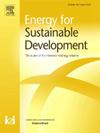The potential of electric agriculture and mobility for the least-cost rural electrification strategy in Sub-Saharan Africa
IF 4.4
2区 工程技术
Q2 ENERGY & FUELS
引用次数: 0
Abstract
Electrification is a crucial driver of rural development in Sub-Saharan Africa (SSA), yet progress is often impeded by low demand density, particularly for grid extension. Despite the promising potential of stand-alone and mini-grid systems, rural areas frequently lag behind due to their low economic viability in electrification. Simultaneously, the mechanization of agriculture and the motorization of transport offer the opportunity to increase economic activity. This publication explores the role of electric vehicles (EVs) and electric tractors (ETs) in rural electrification scenarios.
We present a methodology to quantify the theoretical impact of EVs and ETs on SSA’s electrification strategies, applied specifically to Nigeria and Chad. Our simulations in Nigeria reveal that not only supply options with higher capacity are needed, but that EVs have the potential to lower the cost of electricity (LCOE) by an average of 54 %, and ETs have the potential to reduce LCOE by 49 %, depending on local mobility and mechanization demand. Rural areas with significant cropland particularly benefit from using ETs to achieve cheaper electricity access. In Chad, where grid infrastructure is minimal, our assessment shows that EVs and ETs can significantly influence least-cost electrification strategies. By 2030, mini-grids will become the least-cost supply option for 60 % of the newly connected population, compared to just 13 % when only residential demand is considered.
Our methodology advances the widely used ONSSET electrification planning model to estimate the maximum joint potential of electrified agriculture, electric mobility and adapted rural electrification strategies. Our approach involves geospatially estimating energy demands using macroscopic available population, land cover, and infrastructure data. The findings underscore the importance of jointly implementing EVs and ETs and electrification strategies for technology leapfrogging, highlighting the economic viability and potential of EVs and ETs in rural scenarios. The results provide policymakers with quantitative indicators on the impact of the implementation for Nigeria and Chad.
电动农业和流动性在撒哈拉以南非洲成本最低的农村电气化战略中的潜力
电气化是撒哈拉以南非洲(SSA)农村发展的重要推动力,但由于需求密度低,尤其是电网扩展需求密度低,电气化的进展往往受到阻碍。尽管独立电网和微型电网系统潜力巨大,但农村地区由于电气化的经济可行性较低,往往落在后面。与此同时,农业机械化和交通运输机动化为增加经济活动提供了机会。本刊物探讨了电动汽车(EV)和电动拖拉机(ET)在农村电气化方案中的作用。我们提出了一种方法来量化电动汽车和电动拖拉机对撒哈拉以南非洲地区电气化战略的理论影响,并具体应用于尼日利亚和乍得。我们在尼日利亚进行的模拟显示,不仅需要更大容量的供应选择,而且电动汽车有可能将电力成本(LCOE)平均降低 54%,而风电有可能将 LCOE 降低 49%,这取决于当地的流动性和机械化需求。拥有大量耕地的农村地区尤其能从使用风电机组获得更便宜的电力供应中获益。在电网基础设施极少的乍得,我们的评估显示,电动汽车和风电可以显著影响最低成本电气化战略。到 2030 年,微型电网将成为 60% 新接入人口的最低成本供电选择,而仅考虑住宅需求时,这一比例仅为 13%。我们的方法推进了广泛使用的 ONSSET 电气化规划模型,以估算电气化农业、电动交通和经调整的农村电气化战略的最大联合潜力。我们的方法包括利用现有的宏观人口、土地覆盖和基础设施数据对能源需求进行地理空间估算。研究结果强调了联合实施电动汽车和电动交通以及电气化战略对于实现技术跨越的重要性,突出了电动汽车和电动交通在农村场景中的经济可行性和潜力。研究结果为政策制定者提供了有关实施电动汽车和电子技术对尼日利亚和乍得影响的量化指标。
本文章由计算机程序翻译,如有差异,请以英文原文为准。
求助全文
约1分钟内获得全文
求助全文
来源期刊

Energy for Sustainable Development
ENERGY & FUELS-ENERGY & FUELS
CiteScore
8.10
自引率
9.10%
发文量
187
审稿时长
6-12 weeks
期刊介绍:
Published on behalf of the International Energy Initiative, Energy for Sustainable Development is the journal for decision makers, managers, consultants, policy makers, planners and researchers in both government and non-government organizations. It publishes original research and reviews about energy in developing countries, sustainable development, energy resources, technologies, policies and interactions.
 求助内容:
求助内容: 应助结果提醒方式:
应助结果提醒方式:


